From Wiki...
Nandas (http://en.wikipedia.org/wiki/Nanda_Dynasty)

The Nanda Empire at its greatest extent under Dhana Nanda circa 323 BC.
The Nandas are sometimes described as the first empire builders of India. They inherited the large kingdom of Magadha and wished to extend it to yet more distant frontiers. To this purpose they built up a vast army consisting of 200,000 infantry, 20,000 cavalry, 2,000 war chariots and 3,000 war elephants (at the lowest estimates). According to Plutarch however, the size of the Nanda army was even larger, numbering 200,000 infantry, 80,000 cavalry, 8,000 war chariots, and 6,000 war elephants.
However, the Nandas never had the opportunity to use this army against the Greeks, who invaded India at the time Dhana Nanda, since Alexander's campaign terminated in the Punjab. Alexander's campaign terminated in the Punjab because of the powerful empire of Magadha ruled by the Nanda dynasty. Fearing the prospects of facing another powerful Indian army and exhausted by years of campaigning, his army mutinied at the Hyphasis River (the modern Beas River) refusing to march further east.
The Nandas made the methodical collection of taxes by regularly appointed officials a part of their administrative system. The treasury was continually replenished, the wealth of the Nandas being well-known. The Nandas also built canals and carried out irrigation projects. The possibility of an imperial structure based on an essentially agrarian economy began to germinate in the Indian mind.
__________________
Mauryans (http://en.wikipedia.org/wiki/Maurya_Empire)
Chandragupta Maurya (BC 320 - 298) (http://en.wikipedia.org/wiki/Chandragupta_Maurya)
Chandragupta's empire when he founded it circa 320 BC, by the time he was about 20 years old.
In 321 BCE, exiled general Chandragupta Maurya, under direct patronage of the genius of Chanakya, founded the Maurya dynasty after overthrowing the reigning king Dhana Nanda. Most of the subcontinent was united under a single government for the first time under the Maurya rule. Mauryan empire under Chandragupta would not only conquer most of the Indian subcontinent, but also push its boundaries into Persia and Central Asia, conquering the Gandhara region. Chandragupta Maurya is credited for the spread of Jainism in southern Indian region.
Ashok (BC 273 - 232) (http://en.wikipedia.org/wiki/Ashoka)

Map depicting the largest extent of the Mauryan Empire in dark blue, and allied or friendly areas in light blue
The Mauryan dynasty under Ashoka was responsible for the proliferation of Buddhist ideals across the whole of East Asia and South-East Asia, fundamentally altering the history and development of Asia as a whole.
_____________
Satvahanas (http://en.wikipedia.org/wiki/Satavahana)
Gautamiputra Satakarni (78-102 AD)
Gautamiputra Satakarni (also known as Shalivahana) (c. 78-102 AD) was the twenty-third ruler of the Satavahana Empire. He succeeded his father, Emperor Satakarni.
Gautamiputra Satakarni, often acknowledged by historians as the greatest of the Satavahana rulers, took to the throne after his father, Satakarni. Satakarni had earlier expanded the Satavahana Empire and gained considerable prosperity due to his two Aswamedha sacrifices. However, when Gautamiputra ascended the throne, the Satavahana Empire was loosely attached and was facing the threats of invasions from Sakas and Yavanas. However, Gautamiputra defeated the Yavanas, Sakas and Pahlavas and re-established the ancient glory of the Satavahanas.
______________
Guptas (http://en.wikipedia.org/wiki/Gupta_Empire)
Samudragupta (AD 335 – 380) (http://en.wikipedia.org/wiki/Samudragupta)
Samudragupta, ruler of the Gupta Empire (c.AD 335 – 380), and successor to Chandragupta I, is considered to be one of the greatest military geniuses in Indian history. His name is taken to be a title acquired by his conquests (Samudra referring to the 'oceans').
Chandragupta Vikramaditya (AD 375 - 413/15)
(http://en.wikipedia.org/wiki/Chandragupta_II)
Chandragupta II (very often referred to as Vikramaditya or Chandragupta Vikramaditya) was one of the most powerful emperors of the Gupta empire. His rule spanned 375-413/15 CE, during which the Gupta empire achieved its zenith. The period of prominence of the Gupta dynasty is very often referred to as the Golden Age of India.
_______________
Harshavardhana (AD 590 - 647) (http://en.wikipedia.org/wiki/Harsha)
Harsha or Harshavardhana (????????� 344;) (590–647) was an Indian emperor who ruled Northern India for over forty years. He was the son of Prabhakar Vardhan and younger brother of Rajyavardhan, a king of Thanesar. At the height of his power his kingdom spanned the Punjab, Bengal, Orissa and the entire Indo-Gangetic plain north of the Narmada River.
Harsha's empire at its greatest extent
After the downfall of the Gupta Empire in the middle of the sixth century C.E., North India reverted back to small republics and small monarchical states. Harsha united the small republics from Punjab to Central India, and they, at an assembly, crowned Harsha king in April 606 AD when he was merely 16 years old.
____________
Cholas
Rajaraja Chola I ( AD 985 - 1014) (http://en.wikipedia.org/wiki/Rajaraja_Chola_I)
Extent of the Chola Empire under Rajaraja the Great c.1014 C.E.
Rajaraja Chola I (Tamil: ??????? ?????) is considered by many as the greatest king of the Chola Empire, who ruled between 985 and 1014 CE. He laid the foundation for the growth of the Chola kingdom into an empire, by conquering the kingdoms of southern India and the Chola Empire expanded as far as Sri Lanka in the south, and Kalinga (Orissa) in the northeast. He fought many battles with the Chalukyas in the north and the Pandyas in the south. By conquering Vengi, Rajaraja laid the foundations for the Chalukya Chola dynasty. He invaded Sri Lanka and started a century-long Chola occupation of the island.
He streamlined the administrative system with the division of the country into various districts and by standardising revenue collection through systematic land surveys. He built the magnificent Brihadisvara Temple in Thanjavur and through it enabled wealth distribution amongst his subjects. His successes enabled the splendid achievements of his son Rajendra Chola I under whom the empire attained the greatest extent and carried its conquest beyond the seas.
Rajendra Chola I (AD 1012 - 1044) (http://en.wikipedia.org/wiki/Rajendra_Chola_I)
Rajendra Chola's Territories c. 1030 C.E
Rajendra Chola I was the son of Rajaraja Chola I, the great Chola king of South India. He succeeded his father in 1014 C.E. as the Chola emperor. During his reign, he extended the influences of the already vast Chola empire up to the banks of the river Ganges in the north and across the ocean. Rajendra's territories extended coastal Burma, the Andaman and Nicobar Islands, Lakshadweep, Maldives, conquered the kings of Srivijaya (Sumatra, Java and Malaya in South East Asia) and Pegu islands with his fleet of ships. He defeated Mahipala, the Pala king of Bengal and Bihar, and to commemorate his victory he built a new capital called Gangaikonda Cholapuram. Tamil Chola armies exacted tribute from Thailand and the Khmer kingdom of Cambodia. Rajendra was the first Indian king to take his armies overseas. He also built a temple for Siva at Gangaikonda Cholapuram, similar in design to the Tanjore Brihadisvara Temple built by Rajaraja Chola. He assumed titles Parakesari and Yuddhamalla.
Edited by SolidSnake - 16 years ago
























comment:
p_commentcount